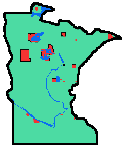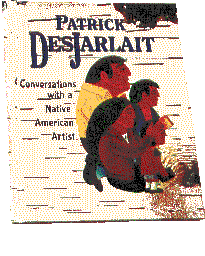Minnesota
RED LAKE Band of CHIPPEWA INDIANS |
 |
|---|---|
|
Federally recognized
Beltrami and Clearwater counties, Minnesota Red Lake consistently resisted all attempts at allottment of their land, whenever they were able to do so, using formal rejections and informal methods such as running off surveyors, social workers, lawyers, missionaries. Other Minnesota Ojibwe tribal bands failed to do this and as a result, although boundaries are drawn around their reservations, their lands are very heavily checkerboarded by non-Indian ownership. Red Lake alone of Minnesota tribes rejected Public Law 280, so unlike other Minnesota reservations, Red Lake retained criminal and civil jurisdiction (except for the federal Major Crimes Act) over its remaining lands and its citizens. Red Lake governs itself and does not belong to the Minnesota Chippewa Tribe Federation, which has various economic and other powers over its members, the other Ojibwe reservations in Minnesota, who all belong to the MCT. Red Lake rejected this, and goes it alone, though there are many relationships and intermarriages among Anishinaabe peoples of Red Lake and the Minnesota Chippewa Tribe (federation). The results of Red Lake's consistent, long-time strategy are best seen in comparing the land they have kept to the land other, more cooperative-with-whites tribes have lost. | |
|
Notable artistic accomplishments by Red Lakers: Painter Patrick Desjarlait and some of his children, especially Robert Desjarlait, who carries on his father's artistic efforts, though with a unique style of his own. This book -- newly reissued with a great many more paintings added since a recent posthumous art show of Desjarlait's work, is available from Lerner Publishing, St. Paul and is highly recommended for readers of all ages. Patrick Desjarlait is one of the few Indian artists before very recent years to achieve commercial success as a commercial illustrator, film cartoonist, and video advertising illustrator, as well as having fine arts works in many Indian museums and private collections. |
| Another well-known artist is Sam English, enrolled as a Turtle Mountain Ojibwe (in North Dakota) he has many relatives from Red Lake. This beautiful picture is the cover of a 1997 calendar illustrated by his paintings, donated to raise money for American Indian Science and Engineering Society. Its beauty will keep it relevant long after this year is gone. See bigger high-quality images, a bio note, and his gallery in Albuquerque (where he now lives) on his web page. The calendar (a beautiful gift) is also avaiable from Fulcrum Publishing, which has an 800 order line. |  |
|
Economically, though it suffers the usual effects of isolation, since 1929 Red Lake has operated a fish marketing co-op that ices, packs and ships catches of individual and family-group net fishers. This may be the oldest Indian-controlled marketing co-op in the western hemisphere. It began well before the Indian Reorganization Act of 1934 (which Red Lake rejected altong with just about every other U.S. governmental action they were able to). The earliest Indian marketing co-ops other than Red Lake began in the Post World War II period. They market only arts and crafts, and are relatively small enterprises. Fishery nearly failed as a local industry due to the effects of acid rain pollution killing off most of the lakes' whitefish -- but some reductions and control of distant industrial air pollution, and a hatchery to restock the lake, have helped restore the fish. In 1982 (most recent figures I've got), the co-op handled 1,880,671 lbs of fish (the beginning of the rebuilding of the fish population, which was decimated in the 1970's). Commercial timberlands occupy 330,000 acres. (Upper and Lower Red Lakes occupy one-third of the total acreage.) For many years the tribe has owned and operated a sawmill, and 2 wood manufacturing plants: the Red Lake Cedar Fence plant and the Red Lake Pre-fab Housing plant. Wild rice became a commercial tribal enterprise in 1968. There are 300 acres in production of paddy or cultivated-seeded rice, with an estimated 55,000 acres considered potentially suitable for cultivation.
Here's their school websites (Dead since spring of 1994 and not very informative; teachers do not anser their email and may have left. Perhaps these school sites will revive sometime): | |

 Because Red Lake altogether rejects state jurisdiction, they issue their own license plates to tribal members without (like the several other Minnesota tribes that have special plates) having to go through the state at all. Here's that famous plate, 1983 version.
Because Red Lake altogether rejects state jurisdiction, they issue their own license plates to tribal members without (like the several other Minnesota tribes that have special plates) having to go through the state at all. Here's that famous plate, 1983 version.